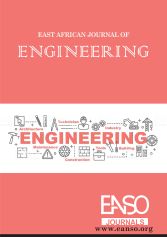Application of Machine Learning in Estimating California Bearing Ratio from Soil Index Properties in Kenya
Résumé
The California Bearing Ratio (CBR) is an important civil and transportation engineering test. It is normally carried out to assess soil's bearing capacity and strength for road pavement and foundation construction. The test, however, is both time-consuming and labour-intensive, resulting in significant delays during the construction process, ultimately leading to financial losses due to the high cost typically associated with construction projects. As a potential solution to this issue, an investigation is conducted into the application of artificial intelligence (AI) and machine learning (ML) techniques for accurately forecasting CBR values. Three models were used in the study, namely, the random forest model, linear regression model, and extreme gradient boosting (XGBoost) model. These models were employed to forecast CBR values based on several soil index properties. These properties included particle size distribution (i.e., percentage of soil passing through the sieve of diameter 0.425mm and 0.075mm), liquid limit (LL), plasticity index (PI), maximum dry density (MDD), plastic limit (PL), and optimum moisture content (OMC). A dataset containing these soil properties and corresponding CBR values for soils was obtained from the University of Nairobi civil engineering laboratory. The models were then trained on 80% of the data and tested on 20%. Mean Absolute Error (MAE), Mean Squared Error (MSE), Root Mean Squared Error (RMSE), and Coefficient of determination (R²) were used to evaluate the accuracy of the predictions. The findings showed that XGBoost was the most accurate model with the lowest MAE, MSE, and RMSE, and the highest R², making it the preferred model for predicting CBR
##plugins.generic.usageStats.downloads##
Références
ASTM D1883-16. (2016). Standard Test Method for California Bearing Ratio (CBR) of Laboratory-Compacted Soils. Astm International.
Çelik, Ö. (2018). A Research on Machine Learning Methods and Its Applications. Journal of Educational Technology and Online Learning. https://doi.org/10.31681/jetol.457046
Cheng, C. L., Shalabh., & Garg, G. (2014). Coefficient of determination for multiple measurement error models. Journal of Multivariate Analysis. https://doi.org/10.1016/j.jmva.2014.01.006
Firican, G. (2022). The History of Machine Learning. Lights On Data.
Friedman, J., Hastie, T., & Tibshirani, R. (2002). Additive logistic regression: a statistical view of boosting (With discussion and a rejoinder by the authors). The Annals of Statistics. https://doi.org/10.1214/aos/1016218223
Huang, S. (2022). Linear regression analysis. In International Encyclopedia of Education: Fourth Edition. https://doi.org/10.1016/B978-0-12-818630-5.10067-3
Janiesch, C., Zschech, P., & Heinrich, K. (2021). Machine learning and deep learning. Electronic Markets. https://doi.org/10.1007/s12525-021-00475-2
Keith D. Foote. (2019). A Brief History of Machine Learning. Https://Www.Dataversity.Net/a-Brief-History-of-Machine-Learning/.
Kwok, S. W., & Carter, C. (1990). Multiple decision trees. In Machine Intelligence and Pattern Recognition. https://doi.org/10.1016/B978-0-444-88650-7.50030-5
Nguyen, B. T., & Mohajerani, A. (2015). Prediction of California Bearing Ratio from Physical Properties of Fine-Grained Soils. International Journal of Civil, Structural, Construction and Architectural Engineering, 9(2), 136– 141. http://citeseerx.ist.psu.edu/viewdoc/download?doi=10.1.1.674.2360&rep=rep1&type=pdf
Sasakawa, T., Hu, J., & Hirasawa, K. (2008). A brainlike learning system with supervised, unsupervised, and reinforcement Learning. Electrical Engineering in Japan (English Translation of Denki Gakkai Ronbunshi). https://doi.org/10.1002/eej.20600
Schonlau, M., & Zou, R. Y. (2020). The random forest algorithm for statistical learning. Stata Journal. https://doi.org/10.1177/1536867X20909688
Su, X., Yan, X., & Tsai, C. L. (2012). Linear regression. Wiley Interdisciplinary Reviews: Computational Statistics. https://doi.org/10.1002/wics.1198
Sylvia, M. L., & Murphy, S. (2023). Exploratory Data Analysis. In Clinical Analytics and Data Management for the DNP, Third Edition. https://doi.org/10.1891/9780826163240.0014
Yoder, E. J., M. W. Witczak, Witczak, M. W., & M. W. Witczak. (1975). Principles of Pavement Design, Second Edition. Principles of Pavement Design.
Copyright (c) 2025 Billy Kipchirchir Koech, Simpson Nyambane Osano, PhD, Abraham Mutunga Nyete, PhD

Ce travail est disponible sous la licence Creative Commons Attribution 4.0 International .




























